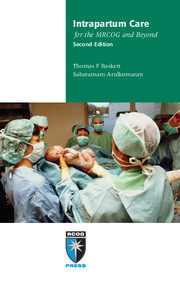Book contents
- Frontmatter
- Contents
- Preface
- Abbreviations
- 1 Improving intrapartum care
- 2 First stage of labour
- 3 Second stage of labour
- 4 Fetal surveillance in labour
- 5 Third stage of labour
- 6 Lower genital tract trauma
- 7 Induction of labour
- 8 Preterm labour and prelabour rupture of membranes
- 9 Assisted vaginal delivery
- 10 Shoulder dystocia
- 11 Breech vaginal delivery
- 12 Twin and triplet delivery
- 13 Caesarean section
- 14 Vaginal birth after caesarean section
- 15 Uterine rupture
- 16 Emergency obstetric hysterectomy
- 17 Cord prolapse
- 18 Antepartum haemorrhage
- 19 Postpartum haemorrhage
- 20 Acute uterine inversion
- 21 Amniotic fluid embolism
- 22 Disseminated intravascular coagulation
- 23 Acute tocolysis
- 24 Severe pre-eclampsia and eclampsia
- 25 Neonatal resuscitation
- 26 Perinatal loss: management of late fetal death and stillbirth
- Index
15 - Uterine rupture
Published online by Cambridge University Press: 05 July 2014
- Frontmatter
- Contents
- Preface
- Abbreviations
- 1 Improving intrapartum care
- 2 First stage of labour
- 3 Second stage of labour
- 4 Fetal surveillance in labour
- 5 Third stage of labour
- 6 Lower genital tract trauma
- 7 Induction of labour
- 8 Preterm labour and prelabour rupture of membranes
- 9 Assisted vaginal delivery
- 10 Shoulder dystocia
- 11 Breech vaginal delivery
- 12 Twin and triplet delivery
- 13 Caesarean section
- 14 Vaginal birth after caesarean section
- 15 Uterine rupture
- 16 Emergency obstetric hysterectomy
- 17 Cord prolapse
- 18 Antepartum haemorrhage
- 19 Postpartum haemorrhage
- 20 Acute uterine inversion
- 21 Amniotic fluid embolism
- 22 Disseminated intravascular coagulation
- 23 Acute tocolysis
- 24 Severe pre-eclampsia and eclampsia
- 25 Neonatal resuscitation
- 26 Perinatal loss: management of late fetal death and stillbirth
- Index
Summary
The hospital incidence of uterine rupture varies from 1/100–500 deliveries in developing countries to 1/1000–5000 deliveries in countries with well-developed hospital services.
The type of rupture may be complete, involving the full thickness of the uterine wall, with or without extrusion of fetal parts, or incomplete, when the uterine muscle has separated but the visceral peritoneum remains intact. Excluding separation of previous uterine scars, the most common site of complete rupture is the anterior lower uterine segment. Uterine rupture may extend laterally with bleeding into the broad ligament and retroperitoneal space. Less common is rupture of both the distended lower segment and the vaginal fornix. In 5–10% of cases, the rupture involves the bladder wall.
In regions with poorly developed obstetric services, the maternal mortality rate can reach 10–20% and the perinatal death rate 40–90%. Although maternal death owing to uterine rupture is uncommon in developed countries, the morbidity for the mother can be high, and can include the need for hysterectomy. In addition, perinatal morbidity as a result of hypoxic–ischaemic encephalopathy is a risk with well-developed services, where the relatively rapid performance of caesarean section may diminish the risk of stillbirth only to salvage a severely hypoxic infant.
- Type
- Chapter
- Information
- Intrapartum Care for the MRCOG and Beyond , pp. 177 - 180Publisher: Cambridge University PressPrint publication year: 2011



